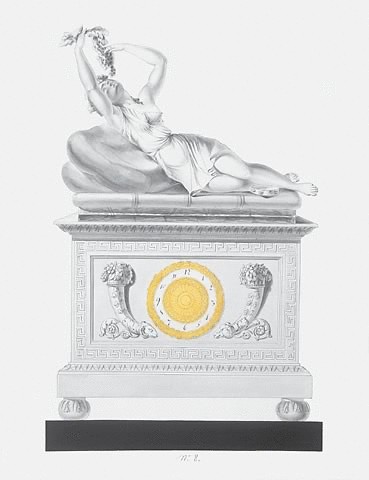Description
To be executed in alabaster; gilt bronze and enamel dial; black marble platform
A voluptuous female figure reclining on pillows, eating grapes from a bunch she is holding aloft, a tambourine by her feet; the Greek key framed plinth with the clock dial flanked by rhyton horns; on foliate clasped ball feet 19in. high
Bacchantes (Maenads in Greek), who had a tambourine for an attribute, were female devotees of Bacchus, the god of wine. This figure's swirling drapery is typical, the pose of the figure expressing physical abandonment, the grapes symbolic of feasting and the heady effects of wine. Bacchic imagery was much employed on dining room clocks.
The presence of a number of clocks of this general form in carved alabaster in the Spanish royal collection (see Carvajal, 380, #375; 410, #406; 423, #420; 441, #440; 444-46, #443-45; 469, #471) indicates that the present design is for an alabaster clock. A softer and lighter material than marble, it allows highly pierced carving for such openwork compositions.
The immediate source for the reclining female figure in this design is found in a series of Empire bacchante clocks, themselves based on a drawing attributed to Pierre-Philip Thomire, in the National Museum, Stockholm (see Ottomeyer & Preschel, II, 708, 25-26). That drawing and its associated clocks are supposedly derived from an earlier Empire clock model called La Liseuse assise sur une canape, the design for which is in the Bibliotheque Nationale, Paris (Cabinet des Estampes, fol. 30). A clock of the Thomire model is illustrated in Ottomeyer & Preschel, II, 379, 5.15.19; others were sold at Ader Paris, June 18, 1948, lot 21 (signed Galle e Paris); Christie's Monaco, June 15, 1997, lot 106 (signed Vallant, Paris); French & Co. Collection, Christie's New York, November 24, 1998, lot 44 (signed Le Roy e Paris); and Sotheby's Amsterdam, October 16-17, 2001, lot 450 (signed Ravrio Bronzier e Paris / Mesnil Hger.). Identical clocks are in the Louvre, Paris; Schloss Fosanerie, near Fulda, Germany; and the Lever Art Gallery, Merseyside, England; another is illustrated in Kjellberg, Pendules, 402.
Medium
Watercolour, gouache and pen and ink, on laid paper
Dimensions:
48.30cm wide 68.00cm high (19.02 inches wide 26.77 inches high)
Status
FOR SALE





